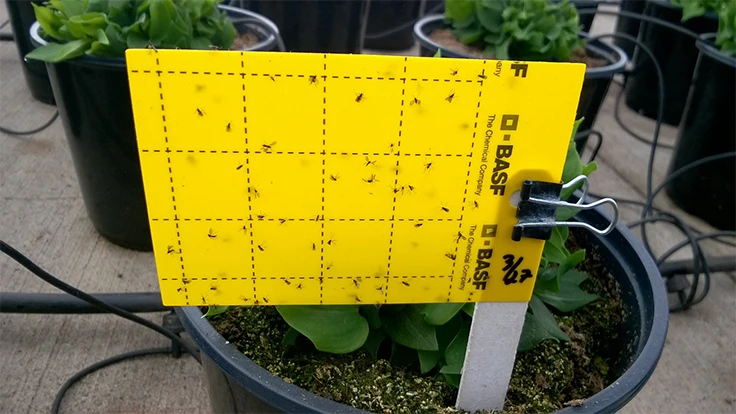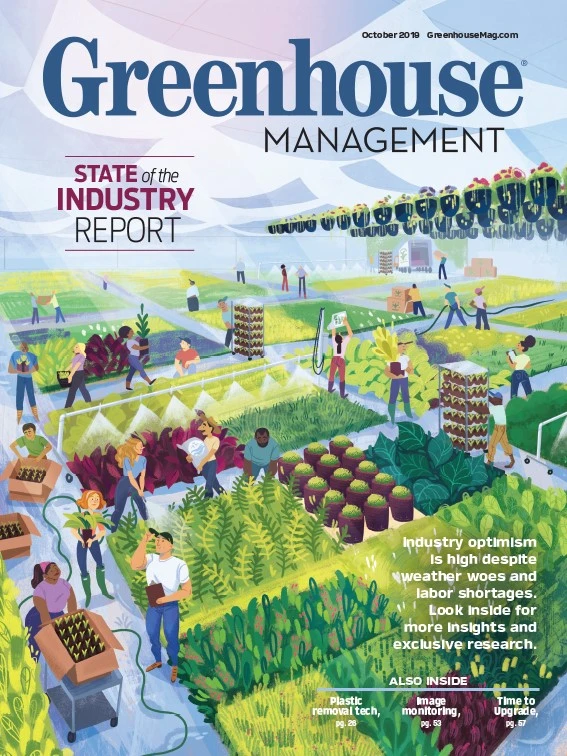

Phytophthora, aphids and weeds are among the funky pests that can complicate greenhouse production. Jen Browning, technical service specialist for western greenhouse, nursery & turf at BASF, adds Pythium and thrips to that list as funky plant pathogens and insect pests, respectively.
Regarding Pythium, Browning says, “That one can be funky because it’s so destructive. When you get it, it’ll just take out an entire tray of young plants.”
With thrips, she says, “Even if you do everything right with all the best chemistries and biologicals and good cultural and mechanical controls, you’re still going to have some amount of thrips — particularly if you are growing flowering plants.”
Growers have multiple resources at their disposal to scout, identify and control funky pests, Browning says. These include experts in the greenhouse, outside help and physical tools.When scouting for insect pests, growers should switch out their sticky cards at least once a week so they know which pest populations are building, she says.
Growers can post their photos of the pest-infested sticky cards, spots on a leaf or an unknown weed on Twitter. The social media tool is a good source for feedback if a grower has trusted professionals from the industry in their network.

Photo courtesy of BASF

“They can take a high-resolution photo of the card and one option is to upload that on Twitter and ask their followers, ‘Do you see anything unusual here?’ ‘Do you see anything funky?’ ‘Do you have any suggestions?’” Browning says. The same method can work on platforms like Facebook and Instagram too.
“While some growers may be wary of asking their peers for this information, they shouldn’t be. And it doesn’t reflect on their skills as a grower,” Browning says. “People love to ID online or make suggestions and help one another.”
If identification via social media isn’t fruitful or growers would like a second opinion, growers can always reach out to their distributor representative.
“Their distributor rep is a good source of information, particularly because that person is very dialed in regionally,” Browning says. “That person will know if other people are having some of the same issues, like a weed that is difficult to control or disease that’s affecting everyone in the same area.”
If the distributor rep is unable to provide an answer, the next step would be to contact the state’s extension office or their manufacturer’s rep. Manufacturers have entomologists, plant pathologists and weed scientists on staff who can have a wealth of knowledge.

In the case of sticky cards, growers can lay clear packing tape on top of the card and mail it to an extension agent, consultant or representative who can identify it in person, Browning says.
As with Twitter, common technology can assist growers in pest identification. Videos will allow fellow growers and technical experts to view insect pests, diseases and weeds from multiple angles or points in time.
“Something like Pythium where the stems rot or snap off at the soil level — you’d be able to see that in video and get an idea that that’s probably Pythium,” Browning says.
The process of identifying and controlling pests can be funky in the event of resistance development. Growers may sometimes get a positive identification on a pest, only to find that a previously proven method of control is less effective than it once was or is no longer effective at all. In these instances, growers can consult with an expert who can help them identify how the pests’ genetics may have changed.
Overall, growers can — and should — lean on each other, peers and experts in the industry to help them control their problem pests in the greenhouse.
Browning offers an excellent reminder to the industry: “There are a lot of different people who are happy to help and try to figure out what’s going on when things get funky.”

Explore the October 2019 Issue
Check out more from this issue and find your next story to read.
Latest from Greenhouse Management
- Anthura acquires Bromelia assets from Corn. Bak in Netherlands
- Top 10 stories for National Poinsettia Day
- Langendoen Mechanical hosts open house to showcase new greenhouse build
- Conor Foy joins EHR's national sales team
- Pantone announces its 2026 Color of the Year
- Syngenta granted federal registration for Trefinti nematicide/fungicide in ornamental market
- A legacy of influence
- HILA 2025 video highlights: John Gaydos of Proven Winners





